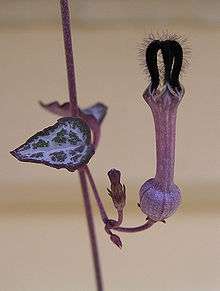Ceropegia
Ceropegia is a genus of plants within the family Apocynaceae, native to Africa, southern Asia, and Australia.[1][2] It was named by Carl Linnaeus, who first described this genus in volume 1 of his Species plantarum, which appeared in 1753. Linnaeus thought that the flowers looked like a fountain of wax. From this the scientific name was derived: kērós meaning wax and pēgḗ meaning fountain (Pooley, 1998). They have many common names including lantern flower, parasol flower, parachute flower, bushman’s pipe, string of hearts, snake creeper, wine-glass vine, rosary vine, and necklace vine.
| Ceropegia | |
|---|---|
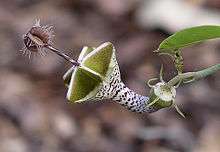 | |
| Ceropegia distincta var. haygarthii | |
| Scientific classification | |
| Kingdom: | Plantae |
| Clade: | Tracheophytes |
| Clade: | Angiosperms |
| Clade: | Eudicots |
| Clade: | Asterids |
| Order: | Gentianales |
| Family: | Apocynaceae |
| Subfamily: | Asclepiadoideae |
| Tribe: | Ceropegieae |
| Genus: | Ceropegia L. |
Ceropegia species are traded, kept, and propagated as ornamental plants.[3] In Africa, the roots and leaves of some species are eaten raw.[4]
Appearance
The stems are vining or trailing in most species, though a few species from the Canary Islands have erect growth habits. Among some species, such as Ceropegia woodii, the nodes swell, and the roots similarly expand to form tubers beneath the soil surface. The leaves are simple and opposite, although they can be rudimentary or absent. Especially in certain succulent species, the leaves may also be thick and fleshy.
The flowers have a tubular corolla with five petals most often fused at the tips, forming an umbrella-like canopy, a cage, or appendage-like antennae.[5] The flowers of this genus are adapted for pollination by flies. A great diversity of fly species are associated with ceropegias. The flowers are often inflated and fused at several points, forming a cage. Flies become momentarily trapped inside, accomplishing pollination as they move about.[3]
Classification
The genus Ceropegia belongs to the subfamily Asclepiadoideae (milkweeds) within the family Apocynaceae. Species of this genus bear similarities to the carrion flowers or stapelias. There are more than 180 known species and more are being discovered and described regularly.[3][6] They are distributed throughout most of sub-Saharan Africa and Madagascar to the Arabian Peninsula, southeast Asia, the Canary Islands, the tropical Pacific, and Australia.[3]
A generic complex, with many interesting taxonomic problems at both generic and specific level, is formed by three genera: Ceropegia, Brachystelma and Riocreuxia.
Selected species
- Ceropegia africana (South Africa)
- Ceropegia ampliata (South Africa)
- Ceropegia antennifera (South Africa)
- Ceropegia arabica (Arabia)
- Ceropegia arenaria
- Ceropegia aridicola
- Ceropegia aristolochoides (Senegal to Ethiopia)
- Ceropegia armandii (Madagascar)
- Ceropegia ballyana (Kenya)
- Ceropegia barbarta (South Africa)
- Ceropegia barkleyi (South Africa)
- Ceropegia bonafouxii (Namibia)
- Ceropegia bosseri (Madagascar)
- Ceropegia cancellata (South Africa)
- Ceropegia candelabrum (Asia)
- Ceropegia carnosa (South Africa)
- Ceropegia ceratophora (Canary Islands)
- Ceropegia chrysantha (Canary Islands)
- Ceropegia cimiciodora (South Africa)
- Ceropegia crassifolia (southern Africa)
- Ceropegia debilis
- Ceropegia decidua (eastern Africa)
- Ceropegia denticulata (tropical Africa)
- Ceropegia devecchii (eastern Africa)
- Ceropegia dichotoma (Canary Islands)
- Ceropegia dimorpha (Madagascar)
- Ceropegia dinteri (Namibia)
- Ceropegia distincta (Zanzibar)
- Ceropegia elegans
- Ceropegia filiformis (South Africa)
- Ceropegia fimbriata (South Africa)
- Ceropegia fusca (Canary Islands)
- Ceropegia galeata (Kenya)
- Ceropegia gemmifera - Togo tangle
- Ceropegia haygarthii (South Africa)
- Ceropegia hians (Canary Islands)
- Ceropegia intermedia (India)
- Ceropegia beddomei (Western Ghats, India)
- Ceropegia jainii (Western Ghats, India)[7]
- Ceropegia juncea (Coast of Coromandel, India)
- Ceropegia krainzii (Canary Islands)
- Ceropegia leroyi (Madagascar)
- Ceropegia linearis (South Africa)
- Ceropegia lugardae (eastern Africa)
- Ceropegia multiflora (southern Africa)
- Ceropegia nilotica (eastern Africa)
- Ceropegia pachystelma (southern Africa)
- Ceropegia petignatii (Madagascar)
- Ceropegia racemosa (tropical Africa)
- Ceropegia radicans (South Africa)
- Ceropegia rendallii (South Africa)
- Ceropegia robynsiana (Congo)
- Ceropegia rupicola (Arabia)
- Ceropegia sandersonii (southern Africa)
- Ceropegia senegalensis (Senegal)
- Ceropegia seticorona (eastern Africa)
- Ceropegia somaliensis (eastern Africa)
- Ceropegia stapeliiformis (South Africa)
- Ceropegia stentii (South Africa)
- Ceropegia striata (Madagascar)
- Ceropegia succulenta
- Ceropegia superba (Arabia)
- Ceropegia turricula (South Africa)
- Ceropegia variegata (Arabia)
- Ceropegia verrucosa
- Ceropegia viridis (Madagascar)
- Ceropegia woodii - string of hearts
- Ceropegia zeyheri (South Africa)
Gallery
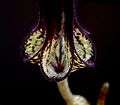
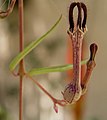
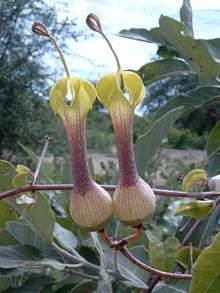 Ceropegia rhynchantha
Ceropegia rhynchantha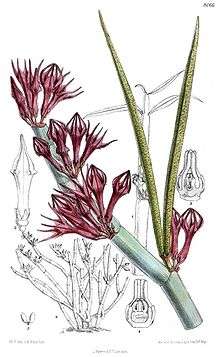
References
- Bruyns, P. V. & P. I. Forster. 1991. Recircumscription of the Stapelieae (Asclepiadaceae). Taxon 40(3): 381–391
- Flora of China Vol. 16 Page 266 吊灯花属 diao deng hua shu Ceropegia Linnaeus, Sp. Pl. 1: 211. 1753.
- Ollerton, J., Masinde, S., Meve, U., Picker, M., & Whittington, A. (2009). Fly pollination in Ceropegia (Apocynaceae: Asclepiadoideae): biogeographic and phylogenetic perspectives. Annals of Botany, mcp072.
- Pieroni, Andrea (2005). Prance, Ghillean; Nesbitt, Mark (eds.). The Cultural History of Plants. Routledge. p. 30. ISBN 0415927463.
- Dyer, R.A. 1983. Ceropegia, Brachystelma and Riocreuxia in Southern Africa. A.A. Balkema, Rotterdam.
- Herbert F. J. Huber: Revision of the genus Ceropegia. In: Memórias da Sociedade Broteriana, Volume 12, 1957, S.1-203, Coimbra
- http://indiabiodiversity.org/species/show/265670
